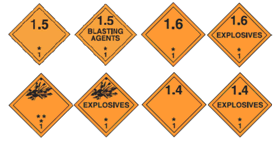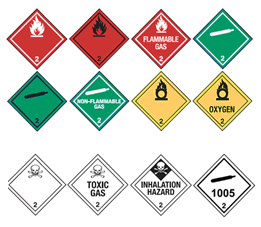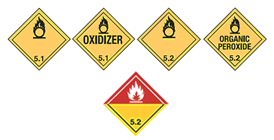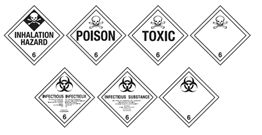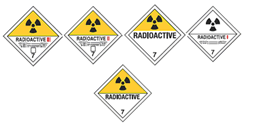TRAFFIC INCIDENT MANAGEMENT IN HAZARDOUS MATERIALS SPILLS IN INCIDENT CLEARANCE
3.0 HAZARD RECOGNITION AT THE SCENE
The primary concern at any incident scene should be the safety of any victims, responders, the motoring public, and the environment. The first step that any first responder must perform is to quickly and accurately identify and assess field conditions to determine the proper actions. It is important to properly identify the presence of potentially harmful materials and to know the necessary mitigation requirements to minimize any harmful threat. The hazardous materials found at roadway incidents may range from normal vehicle fluids to actual cargo contents being transported.
To quickly clear a hazardous material incident (vehicle or cargo spill), first responders should have a good understanding of the many safety, regulatory, disposal guidelines, and documented clean-up practices for spills. Knowledge of these criteria will dictate how quickly a hazardous materials incident is cleared from the roadway and how safely the job is performed. These criteria will also dictate the types of techniques that will be used to clean-up the spill and how quickly the techniques are implemented.
The DOT places strict guidelines on the proper labeling, marking, and placarding of hazardous materials offered for transport. These valuable tools are critical to the identification of hazards at the scene. Hazard recognition also plays an important role in scene management and incident mitigation.
Personnel responding to the scene of an incident have to be keenly aware of their surroundings. Storm drains, water sources, wind direction, and the ground’s gradient are all critical clues that are important to the mitigation of an incident. When used in combination with packaging, container types, vehicle shape, labels, and placards, response personnel can develop a plan of attack for mitigating a hazardous material release.
For most traffic incidents, responders should note the type of vehicle, any placards, the container or tank type, and labeling. These items often dictate the amount and type of material that can be spilled and the hazards associated with the material. They are also important to incident clearance and the approach responders use to mitigate a traffic incident.
According to the FHWA Office of Operations Web site dealing with hazardous materials response procedures, “While some materials are extremely hazardous in any quantity, hazardous materials response procedures are frequently invoked when a gasoline or diesel fuel spill exceeds a legally specified amount, typically 25 gallons. Some states have adopted procedures that exempt larger spills of engine fluids (gasoline, diesel fuel, oil, anti-freeze, etc.) from hazardous materials response procedures, providing that the spill has been contained on the pavement. The USDOT regulations and guidelines for hazardous materials apply only to materials being transported, not engine fluids.”4
The average volume of operating fluids, excluding fuel in a car, is approximately 8.6 liters (approximately 2 ¼ gallons). Table 2 provides information representative of the average volume of the various types of fluids that can be expected from a car. Responders can use this information along with fuel tank capacity of the various vehicle makes to gauge the quantity of fluids involved in clean-up. Given these volumes, one can assess a reasonable quantity to a spill and provide a prospective with which to judge the amount. It is generally accepted that clean-up of spills under the reporting quantity of 25 gallons of normal vehicular fluids can be safely handled by First Responder-Operations Level certified personnel (see Chapter 4).
Table 2. Average Volume of Operating Fluids (Except Fuels) for Cars5
Engine oil |
2.6 liters |
|---|---|
Transmission oil |
1.3 liters |
Final drive oil |
1.1 liters |
Steering gear oil |
0.8 liters |
Coolant |
2.8 liters |
Maximum fuel tank capacity will vary with the vehicle make and model, with the largest tank volume being the saddle tank (normally 70 gallons) on a semi-truck. Depending on the number of tanks on the truck, the maximum capacity for fuel for a commercial vehicle can be as much as 350 to 420 gallons.
With the ever increasing number of hybrid vehicles on the roads, first responders must also be alert to the type of batteries in the various makes of hybrid vehicles. Depending on the technology, some the batteries may be dry cell while others are wet cell.6 The wet cell technology generally contains sulfuric acid or sodium hydroxide that can be cleaned-up using a universal absorbent in accordance with Guide 154 in the DOT Emergency Response Guidebook (ERG).
Hazardous material placards are one of the best clues that a responder can use to quickly size up an incident when some type of cargo is involved. The DOT ERG Table of Placards (2008) provides a quick index for responders to identify the placards currently in use in the U.S.
Table 3. DOT ERG Table of Placards (2008)7
Class 1: Explosives |
Class 2: Gases |
Class 3: Flammable and Combustible liquids |
Class 4: Flammable Solids, Spontaneously Combustible, Dangerous When Wet |
Class 5: Oxidizers and Organic Peroxides |
Class 6 Toxics and Infectious Substances |
Class 7 |
Class 8 |
Class 9 |
Mixed load |
Marine pollutant; Aquatic Toxicity Bulk Packaging Display |
|
The U.S. is beginning an effort to conform to the United Nations standard of labeling, the Globally Harmonized System (GHS) of Classification and Labeling of Chemicals.7 GHS is an internationally agreed upon system set to replace the various different classification and labeling standards used in different countries. GHS hazard classification criteria were selected for physical hazards and key health and environmental classes. For each of these hazard classes, standardized label elements—including symbols, signal words, and hazard statements—have been developed and agreed on. In addition, a standard format and approach to how GHS information appears on safety data sheets has been adopted.
Within the U.S., federal agencies with responsibility for regulatory and international affairs have formed an interagency committee to undertake GHS implementation. Lead by the Department of State, the U.S. Environmental Protection Agency (EPA), the U.S. DOT Pipeline and Hazardous Materials Safety Administration (PHMSA), Occupational Safety and Health Administration (OSHA), the Consumer Product Safety Commission (CPSC), the Department of Commerce, the Food and Drug Administration (FDA), the Office of the U.S. Trade Representative, the Department of Agriculture, and the National Institute of Environmental Health Sciences. GHS is in various stages of planning and implementation. These implementations have affected, and will continue to affect, how response personnel recognize hazards at the scene of a spill. The DOT has modified, or is planning to modify, most of its regulations to incorporate elements of the GHS that affect its programs. Criteria for physical hazards have been substantively aligned with GHS via HM-215I rule-making.9 PHMSA has also adopted several elements of GHS in rulemaking HM-215F,10 that directly affect the transport sector. For example, changes have been made to the hazard classification criteria for toxic materials and flammable liquids. In addition, the organic peroxide placard has also been modified so that the upper half is red and the lower half is yellow.
The GHS utilizes a number of other placards, and the DOT plans to implement some of these placards in the future. Table 4 illustrates the United Nations GHS Pictograms that may be implemented by the U.S. DOT in the future.
The next changes slated by the DOT relate to environmentally hazardous substances (aquatic toxicity). The 2008 ERG includes the “fish and tree” placard in its Table of Placards; this marking has been adopted and authorized under HM-215J. It must be used effective 1/14/2010.
Table 4. Proposed United Nations GHS Pictograms. All rights reserved.7
 |
 |
 |
 |
 |
 |
 |
 |
 |
Other key resources that responders will be able to utilize include hazard communication systems and packing groups. While not as prevalent for vehicle spills, hazard communication systems provide valuable information for hazardous material cargo spills. The National Fire Protection Association (NFPA) 704M,11 Hazardous Materials Identification System (HMIS®)12 and the Hazardous Material Identification Guide (HMIG)13 are often used on individual containers, tanks (intermodal, Baker, etc), drums, and barrels found inside semi-trailers.
The hazard communication systems (NFPA, HMIS, and HMIG) utilize a color-coded system to communicate hazards associated with materials in regards to health, flammability, and reactivity hazard.
The blue, red, and yellow colored areas indicate the health, flammability, and reactivity hazard associated with a material, respectively. A value of zero in one of these areas indicates that the material poses essentially no hazard; a rating of four indicates extreme danger.
Packing groups are central to the hazard recognition process for a hazardous material cargo spill; especially those spills that result from damaged packaging. They also indicate the strength of packaging required for shipment. Division 2.1, 2.2, and 2.3, Division 6.2 (other than "Regulated medical waste," UN3291) and Class 7 materials have no packing group assignments. Class 1 explosives, unless otherwise noted in the HMR, and Division 5.2 materials are assigned packaging group II. Class 3, Division 4.1, 4.2, 4.3, Division 5.1, Division 6.1, and Class 8 materials have been divided into three packing groups:
- PG I – Great danger; = X (UN)
- PG II – medium danger; = Y (UN)
- PG III – low danger; = Z (UN)
A hazardous material is assigned to one of three packing groups based upon its degree of hazard—from a high hazard (Packing Group I) to a low hazard (Packing Group III). The quality, damage resistance, and performance standards of the packaging in each packing group are appropriate for the hazards of the material transported.
Packing group markings (as indicated by the letters above) are found on the packaging and indicate the performance standard under which the packaging design type has been successfully tested. On shipping papers the packing group is identified in the basic description using roman numerals, i.e. PG I.
